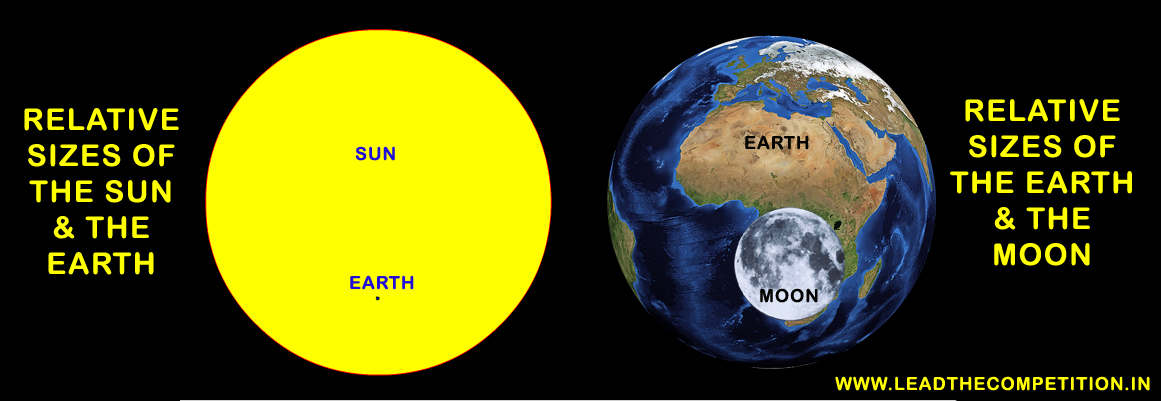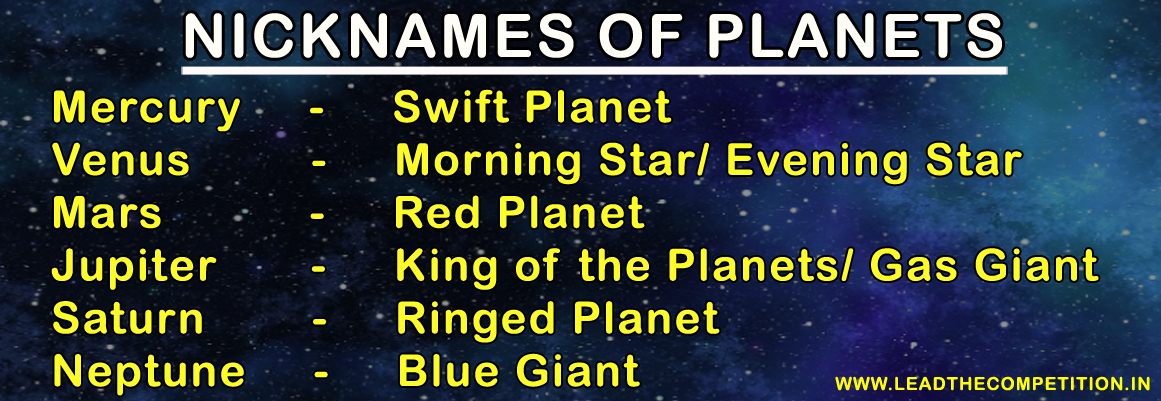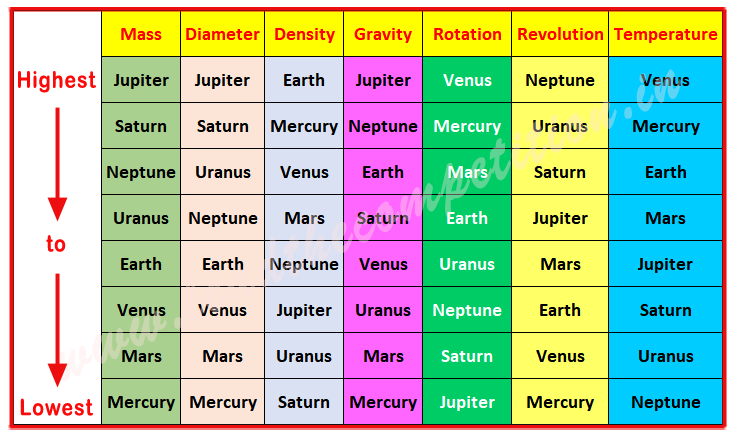Facts about the Solar System
*** इस पृष्ठ को हिंदी में पढ़े ***
The Solar System consists of the Sun, the 8 planets, the dwarf planets, asteroids, moons orbiting the planets, comets and meteoroids. The solar system extends upto the Heliopause, which is considered as its theoritical boundary. The heliopause is located at an estimated distance of 120 AU (Astronomical Unit).
Table of Contents
The Sun
- The Sun is the largest object of our solar system. It has a diameter of 1.4 million kilometers which is about 100 times the diameter of Earth.
- The Sun is located about 150 million kilometers from Earth. The distance is defined as one Astronomical Unit. It is exactly defined as 1,49,59,78,70,700 meters.
- The age of Sun is estimated to be about 4.5 billion years.
- The Sun is an average sized star in its Yellow Dwarf stage.
- The Sun is mainly composed of hydrogen and helium. Other elements form a miniscule percentage of the total mass of the Sun.
- The source of energy is the nuclear fusion taking place in the core of the Sun where hydrogen is being converted into helium.
- The Sun has 3 inner layers, namely, the Core, the Radiative Zone and the Convective Zone.
- The Sun has 4 outer layers, namely, the Photosphere, the Chromosphere, the Transition Region and the Corona.
- The photosphere is the layer where sunlight is emitted, and it contains various features, including sunspots, granules, and faculae.
- The Chromosphere is visible during solar eclipses as a reddish-pink layer around the solar limb.
- The corona is visible during solar eclipses as a faint, outer halo. It extends into space and is the source of the solar wind.

Types of Planets
- There are 8 planets in the solar system of which 4 are Terrestrial planets – Mercury, Venus, Earth and Mars and 4 are Jovian planets – Jupiter, Saturn, Uranus, Neptune
- Terrestrial planets are rocky and composed mostly of metal and silicate rock. They are characterized by solid surfaces and relatively high densities.
- Jovian planets are also known as gas giants, and they are primarily composed of hydrogen and helium. These planets are much larger than terrestrial planets and have lower densities.
- Besides the above, there are 5 Dwarf planets – Ceres, Pluto, Haumea, Makemake and Eris
- Dwarf planets are celestial bodies that orbit the Sun and share some characteristics with both planets and asteroids. Unlike planets, dwarf planets have not cleared their orbits of other debris.
- Ceres lies in the asteroid belt which is between Mars and Jupiter while Pluto, Haumea and Makemake lie in the Kuiper belt and Eris lies beyond the Kuiper belt.
Facts about Planets
- The brightest planet as seen from Earth is – Venus
- The planet also known as Earth’s twin is – Venus
- The planet, which rotates in a direction opposite to that of others is – Venus
- The planet, which is tilted about an angle of 98 degrees relative to its orbital plane around the Sun is – Uranus
- The planet, which has prominent rings around it is – Saturn
- Planets which have no satellites are – Mercury & Venus
- The planet with the longest day is – Venus (243 earth-days)
- The planet with the shortest day is – Jupiter (9 hrs 55 mts)
- The planet also known as Evening/Morning star is – Venus
- The hottest planet in the solar system is – Venus (Maximum temp: 462° C)
- The coldest planet in the solar system is – Uranus (Effective temp: - 216° C)
- The planet with the highest density in the solar system is – Earth
- The planet with the lowest density in the solar system is – Saturn
- The planet also known as the Red Planet is – Mars
- The highest known mountain in the solar system Olympus Mons is located on – Mars
- The planet whose density is less than that of water – Saturn
- The planet with highest surface gravity (meter per square second) is – Jupiter (24.92)
- The planet with lowest surface gravity (meter per square second) is – Mercury (3.7)
- The space between Mars and Jupiter consisting of millions of asteroids is knowns as the – asteroid belt
- The disc-shaped region of icy bodies and comets beyond the orbit of Neptune is known as – Kuiper belt
Moons of Planets
- A moon is a natural satellite of a planet. It is a celestial body that orbits a planet. Moons are much smaller than planets, and they are gravitationally bound to their parent planets.
- Mercury and Mars have no moons.
- Earth has 1 moon and is known as moon.
- Mars has 2 moons named Phobos and Deimos.
- Jupiter has 95 moons (as of October 2023). The prominent ones are - Europa, Io, Ganymede, Callisto, Thebe, Metis etc.
- Saturn has 146 moons, the prominent ones are Mimas, Enceladus, Tethys, Dione, Rhea, Titan, Iapetus etc.
- Uranus has 27 moons, some of which are Ariel, Umbriel, Titania, Oberon, Miranda etc.
- Neptune has 14 moons, some of which are Triton, Naiad, Thalassa, Halimede etc.
- Dwarf planet Pluto has 5 moons which are named Charon, Styx, Nix, Kerberos and Hydra.
Discovery of Planets & Dwarf Planets
- Mercury, Venus, Earth, Mars, Jupiter and Saturn were known since ancient times and do not have distinct discovery dates.
- Uranus was discovered by German-born British astronomer Sir William Herschel on March 13, 1781.
- Neptune was discovered by German astronomer Johann Galle and his assistant Heinrich d'Arrest on September 23, 1846, based on predictions by French mathematician Urbain Le Verrier.
Dwarf Planets
- Pluto was discovered by American astronomer Clyde Tombaugh on February 18, 1930. Pluto was considered the ninth planet in our solar system until it was reclassified as a dwarf planet by the International Astronomical Union (IAU) in 2006.
- Eris was discovered in 2005, Eris is located in the scattered disc, a distant region of the solar system.
- Haumea was discovered in 2004, Haumea is a dwarf planet located in the Kuiper Belt.
- Makemake was discovered in 2005 and is located in the Kuiper Belt. It is the second brightest dwarf planet after Pluto.
- Ceres was discovered in 1801, Ceres is unique among dwarf planets because it is located in the asteroid belt between Mars and Jupiter. It was the first dwarf planet to be visited by a spacecraft when NASA's Dawn mission arrived in orbit around Ceres in 2015.
How Planets have been named?
- Mercury has been named after Roman god Mercurius, god of commerce, communication and the messenger of gods.
- Venus is named after Roman goddess of love.
- Mars is named after Roman god of war.
- Jupiter is named after the chief deity of ancient Roman religion.
- Saturn is named after Roman god of wealth and agriculture.
- Uranus is named after Greek god of sky.
- Neptune is named after Roman god of sea.
Nicknames of Planets

Planets - Rotation & Revolution Periods
| Planet | Rotation Period | Revolution Period |
|---|---|---|
| Mercury | 58.65 Earth Days | 87.97 Earth Days |
| Venus | 243 Earth Days | 224.7 Earth Days |
| Earth | 23.93 Earth Hours | 365.26 Earth Days |
| Mars | 24.62 Earth Hours | 686.93 Earth Days |
| Jupiter | 9.8 Earth Hours | 11.86 Earth Years |
| Saturn | 10.2 Earth Hours | 29.46 Earth Years |
| Uranus | 17.9 Earth Hours | 83.75 Earth Years |
| Neptune | 19.1 Earth hours | 163.72 Earth Years |
Atmospheric Composition of Planets
| Planet | Atmospheric Composition |
|---|---|
| Mercury | Oxygen, Sodium, Hydrogen, Helium |
| Venus | Carbon dioxide, Nitrogen |
| Earth | Nitrogen, Oxygen, Argon |
| Mars | Carbon dioxide, Nitrogen, Argon |
| Jupiter | Hydrogen, Helium |
| Saturn | Hydrogen, Helium |
| Uranus | Methane, Hydrogen, Helium |
| Neptune | Methane, Hydrogen, Helium |
Features of Planets - from highest to lowest
